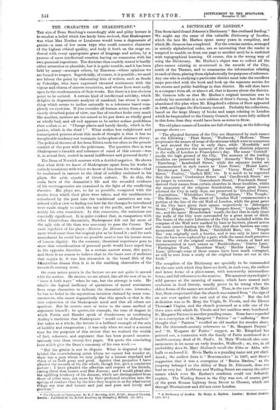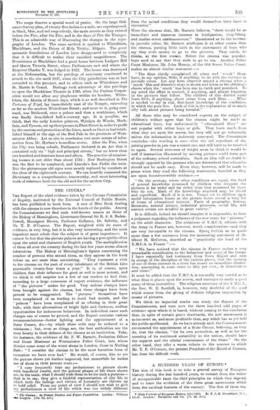A DICTIONARY OF LONDON.•
Tao Soots laird found Johnson's Dictionary " fine confused feeding." We might say the same of this valuable Dictionary of London, which the late Mr. Harben spent many years in compiling, and which Mr. Greaves has completed. For the concise entries, arranged in strictly alphabetical order, are so interesting that the reader is tempted to ramble on from one page to another until he is surfeited with topographical learning. Of course, this is the wrong way of using the Dictionary. Mr. Harben's object was to collect all the place-names existing or mentioned in the records of the City, north of the Thames, and to summarize the information relating to each of them, placing them alphabetically for purposes of reference. Any one who is studying a particular district must take the excellent maps provided with the book and look up the separate entries for the streets and public buildings in that district. He will then have in a compact form all, or almost all, that is known about the district. Mr. Greaves tells us that Mr. Harben's original intention was to embody his materials in a new edition of Stow's Survey, but that he abandoned this plan when Mr. Kingsford's edition of Stow appeared in 1908, and began the Dictionary instead. Probably his collections, based on the large library of books and maps relating to London which he bequeathed to the County Council, were more fully utilized in this form than they would have been as notes to Stow.
The old place-names of London are full of meaning, as the following passage shows :—
" The physical features of the City are illustrated by such names as the following ' Fleet Street," Walbroolc," Holborn.' These perpetuate the names of some of the streams which were so numerous in and around the City in early days, while Moorfields ' and ' Finsbury' preserve the memory of the marshy districts adjacent to the walla of London in Fitzstephen's day. The name ' Cornhill marks the high ground of the City. The memory of the trading localities are preserved in ' Cheapside ' (formerly West Chops'),
Eastcheap," Leadenhall Street,' while the separate trades are commemorated in such names as ' Lhne Street,' Hosier Lane,' Ironmonger Lane,' Seacoal Lane,' Vintry Ward,' Wood. Street,' Poultry," Garlick Hill,' etc. It is much to be regretted that the names ' Cordwainer Street' and ' Candlewick Street' are no longer in existence. ' Gracechurch Street," Fenehurch Street' derived their names from certain churches in these localities, whilst the memories of the religious foundations, whose great houses adorned the City in early days, are preserved in ' Crotched Friars,' Asistinfriars," Whitefriars Street,' Blackfriars," The Temple,' The Minories,' etc. The street of ' London Wall ' commemorates a portion of the line of the old Wall of London, while the great gates of the City have given their names respectively to Aldersgete Street," Aldgate," Bishopsgate,' ' Newgate Street,' Ludgato
etc., and the name' Houndsditch ' recalls the fact that in early times the walls of the City were surrounded by a great moat or ditch. The limits of the ouster Liberties of the City not included within the compass of the Wall were marked by bars or barriers, placed across the main streets leading into the City, and these barriers are com- memorated in ' Holborn Bars,' Smithfield Bars,' etc. Temple Bar' was originally such a barrier, and it was only in later times that the bars were replaced by a gate, while the name itself preserves the memory of the original conditions. The owners of land are commemorated in such names ss ' Bucklersbury," Gutter Lane,' ' Farringdon Ward,' Bussishaw Ward,' Birchin Lane," Bush Lane,' although some of those names have been much corrupted, as will be seen from a study of the original forms set out in this book."
The compilers of the Dictionary are specially to be commended for the care with which they have set forth, in each case, the earliest and latest forms of a place-name, with noteworthy intermediate forms, and full references to the sources. The amateur etymologist's wild guesses at the meaning of names, which have caused such confusion in local history, usually prove to be wrong when the oldest forms of the names are studied. Thus, in the case of St. Mary Axe, Stow conjectured that the church was named from " the sign of an axe over against the oast end of the church." But the full dedication WAS to St. Mary the Virgin, St. Ursula, and the Eleven Thousand Virgins, and the church possessed as a relic one of the three axes with which St. Ursula and her maidens were butchered. St. Margaret Patens is another puzzling name. Some have regarded it as a corruption of St. Margaret " Patiens " or " suffering " Stow thought that " Patton " recalled an old market for wooden shoes. But the thirteenth-century references to " St. Margaret Patynz " and " St. Margaret de' Patine " suggest, as Mr. Kingsford has pointed out, a connexion with the family of Patin mentioned in a twelfth-century deed of St. Paul's. St. Mary Woolnoth also com- memorates in its name an early founder, Wulfnoth ; so, too, in all probability does St. Mary Abchurch recall the Abbe or Abbe who built or endowed it. Bevis Marks is a puzzling name not yet duel- dated ; the earliest form is " Bowesmarkos " in 1407, and Stow's suggestion that it was a corruption of " Buries Markes," as the property belonged to the Abbey of Bury St. Edmunds, does not lead us very far. Lothbury and Watling Street. are among the other names which even Mr. Harben's erudition could not definitely explain. The Watling Street in the City was not, of course, part of the great Roman highway from Dover to Chester, which rats through Westminster and did not enter London,
• A Dielionory of Loam. By Henry A. Barbee. London : Herbert Jenkins. [428. net4
The maps deserve a special word of praise. On the large Ord- nance Survey plan, of twenty-five inches to a mile, are superimposed, in black, blue, and red respectively, the main streets as they existed before the Fire, after the Fire, and in the days of Pitt the Younger. This is an admirable way of illustrating the changes in the topo- graphy of London. The same method is applied to Whitefriars, Blackfriare, and the Priory df Holy Trinity, Aldgate. The great monastic foundations of London have disappeared so completely that it is difficult to realise their vanished magnificence. The Dominicans at Blackfriars had a great house between Ludgate Hill and Queen Victoria Street, where Parliaments mot and where the Emperor Charles V. was lodged in 1529. The house was destroyed at the Reformation, but the privilege of sanctuary continued to attach to the site until 1097, when the City jurisdiction was at last extended to this precinct, and to others such as Whitefriars and St. Martin lo Grand. Burbage took advantage of this privilege to open the Blackfriars Theatre in 1595, when the Puritan Corpor- ation would not allow any playhouse within its borders. White- friars, the Alsatia of Stuart days, which is so well described in The Fortunes of Nigel, lay immediately east of the Temple, extending as far as the modem Whitefriars Street; and next to it, going east- ward, was Bridewell, once a palace and then a workhouse, which was finally demolished half-a-century ago. It is possible, we think, that the early London printers, Wynkyn de Worde, Mach- linia, and Pynson, set up their presses in Fleet Street in order to profit by the custom and protection of the friars, much as Caxton had estab- lished himself at the sign of the Red Pale in the precincts of West- minster Abbey. Let us cite in conclusion two more scraps of infer- motion from Mr. Harben's boundless stores. After the Fire, when the City was being rebuilt, Parliament declared in an Act that it contained only six " high and principal streets," but no fewer than two hundred and fourteen lanes and alleys. The practice of number- ing houses is not older than about 1704: New Burlington Street was the first to be numbered, and Lincoln's Inn Fields the next. But the picturesque old signs were mostly replaced by numbers at the close of the eighteenth century. We can heartily commend the Dictionary as a comprehensive, trustworthy, and most interesting work of reference both for the old anti for the modem City.















































 Previous page
Previous page